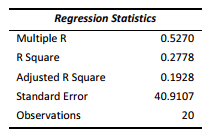SCENARIO 14-6
One of the most common questions of prospective house buyers pertains to the cost of heating in dollars (Y). To provide its customers with information on that matter, a large real estate firm used the following 2 variables to predict heating costs: the daily minimum outside temperature in degrees of Fahrenheit ( X1 ) and the amount of insulation in inches ( X 2 ). Given below is EXCEL output of the regression model.


Also SSR (X1 | X2) = 8343.3572 and SSR (X2 | X1) = 4199.2672
-Referring to Scenario 14-6,the partial F test for
H0 : Variable X2 does not significantly improve the model after variable X1 has been included
H1 : Variable X2 significantly improves the model after variable X1 has been included has _____ and _____ degrees of freedom.
Definitions:
Government Securities
Financial instruments issued by a government to finance its public projects, which include bonds, treasury bills, and notes.
Money Supply
Money Supply refers to the total amount of monetary assets available in an economy at a specific time, including cash, coins, and balances held in checking and savings accounts.
Federal Reserve Board
The governing body of the Federal Reserve System, responsible for overseeing the United States' central banking system and setting monetary policy.
Q16: Referring to Scenario 14-10,the proportion of the
Q30: Referring to Scenario 15-6,the variable X<sub>4</sub> should
Q48: Referring to Scenario 15-6,the model that includes
Q54: Referring to Scenario 14-15,what is the value
Q61: The fairly regular fluctuations that occur within
Q73: Referring to Scenario 17-4,the highest mean weekend
Q91: Referring to Scenario 16-8,the forecast for profits
Q177: Referring to Scenario 14-3,to test whether aggregate
Q234: Referring to Scenario 14-9,what is the value
Q243: Referring to Scenario 14-17,which of the following